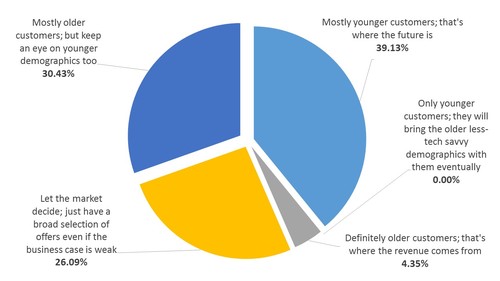|
|
|
Contributors | Messages | Polls | Resources |
|
TT Poll: Pay-TV Is for Everyone Last month our Telco Transformation poll addressed a rather controversial issue in the pay-TV industry: should operators focus on younger, millennial customers or on older, more traditional customers? In recent years the phenomenon of cord-cutting has generated headlines, as pay-TV providers struggle to adapt their business to the needs of younger audiences. These millennial customers want flexible contracts, on-demand services, access via any device of their choice and they want all of this for considerably less than previous generations have paid. Pay-TV providers have created new skinny bundles, expanded their on-demand libraries and launched new multiscreen services to cater to this demand, as cord-cutting starts to eat into their subscriber base. However, the needs and preferences of their larger subscriber base have been getting far less press. Are operators better off making significant investments to address the needs of younger demographics, or are they better served catering to their existing base of more traditional users, who have a far higher willingness to pay, with an average spend per household two to three times that of a skinny bundle? Aren't those subscribers far more important, because they subscribe to full-fat services, which generate far more revenue and greater margins for the operator?
Should pay-TV operators focus on older customers or millennials?

Source: Telco Transformation Flash Poll, May 2017
About two in five respondents (39%) selected that option, well ahead of "Mostly older customers; but keep an eye on younger demographics too," which came in next, with 30% selecting it. This was followed by "Let the market decide; just have a broad selection of offers even if the business case is weak" which was chosen by 26% of respondents. Reading a little between the lines while interpreting the data, it does appear that respondents were looking for a sort of "middle-ground" option, with the more extreme options (focus only on the young, or focus only on the older, traditional subscribers) not getting much of a response. This is underscored by some of the comments from the respondents:
Essentially, respondents don't see pay-TV as a targeted service, but rather something that should have broad appeal. They accept that there might be features or bundles that are designed for one or the other segment, but generally speaking they expect a pay-TV service to have broad appeal and value. — Aditya Kishore, Practice Leader, Video Transformation, Telco Transformation |
Contentious issues that are likely to fuel lawsuits and angry blogs in the coming year.
Content producers are unhappy with the advertising approach and revenues they are getting on Facebook Watch.
OTT video usage is driving the penetration of various Internet connected devices to help view online streams on the larger TV screen.
Major Hollywood studio to trial 'virtual' movie theaters using head-mounted displays.
Network technology vendor Sandvine has found that piracy isn't only hurting network operator profits – each pirated set-top box is also using up 1TB per month in 'phantom bandwidth.'
 On-the-Air Thursdays Digital Audio On-the-Air Thursdays Digital AudioARCHIVED | December 7, 2017, 12pm EST
Orange has been one of the leading proponents of SDN and NFV. In this Telco Transformation radio show, Orange's John Isch provides some perspective on his company's NFV/SDN journey.
 Special Huawei Video Special Huawei VideoHuawei Network Transformation Seminar The adoption of virtualization technology and cloud architectures by telecom network operators is now well underway but there is still a long way to go before the transition to an era of Network Functions Cloudification (NFC) is complete. |
|
|
|
||


















